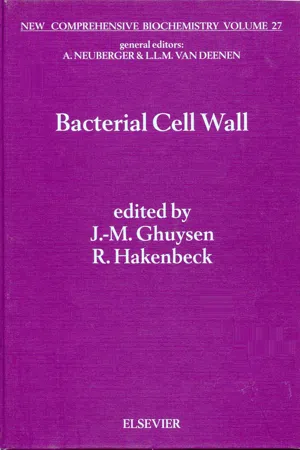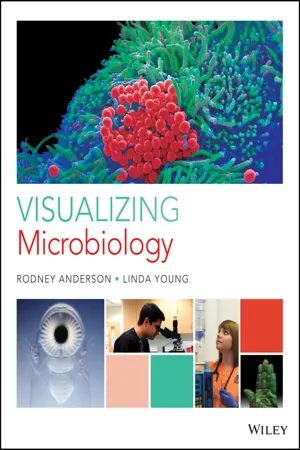Biological Sciences
Bacterial Cell Structure
Bacterial cell structure refers to the organization and components of a bacterial cell. It includes a cell wall, cell membrane, cytoplasm, ribosomes, and genetic material in the form of DNA. Bacterial cells lack a nucleus and other membrane-bound organelles found in eukaryotic cells. The structure of bacterial cells plays a crucial role in their function and interactions with the environment.
Written by Perlego with AI-assistance
Related key terms
1 of 5
12 Key excerpts on "Bacterial Cell Structure"
- eBook - PDF
- I.C. Gunsalus(Author)
- 1960(Publication Date)
- Academic Press(Publisher)
Third, the spurt of effort directed toward the physiology and the genetics of bacteria has brought to light many questions that require answers in terms of structure. More than ever before the fashion and the requirements of biological science focus the attention not merely upon the systematic phenomena but also upon the site, nature, and function of components. Cytological studies of sufficient breadth and detail to be useful in a gen-eral description of internal structure are few and are largely confined to a 35 36 R. G. E. MURRAY small number of bacterial species. This is, perhaps, not surprising, but it is tantalizing because we can now glimpse the bare outline of what can be done to bring our knowledge of bacterial structure to a point where it can be incorporated into the whole picture that we should like to have of the kingdoms of living things. Cytological observations, other than shape and form and habit, are only just becoming convincing to the bacteriologist, let alone the general biologist, and this has been largely stimulated by bio-chemical probing into the nature of some of the tougher and most durable elements of functional structure. All the approaches to the unraveling of structure are bringing to light unique properties of bacteria that will stimu-late more effective research. This chapter attempts to present a general view of what has been learned of the internal structure of bacteria, and a general look at what is on the horizon. It is not a replacement for the general reviews that are available in the literature for those who wish to survey the early literature and also savor the variant and changing shades of opinion; the monographs of Dela-porte, 1 Knaysi, 2 and Bisset 3 should be consulted, as also the reviews of Piekarski, 4 Robinow, 5 Delaporte, 6 and Winkler. - Kumar, Har Darshan(Authors)
- 2021(Publication Date)
- Daya Publishing House(Publisher)
Chapter 5 Microbial Morphology and Physiology Bacterial Cell Walls and Surface Structures Some of the most important structures of microbial cells are their surfaces. The surfaces are in immediate contact with the external environment. The cell walls admit nutrients and release wastes, and yet need to resist internal turgor pressure and environmental insults so as to maintain cellular shape. Walls facilitate adherence of cells to other surfaces and provide space for specialized structures such as flagella, pili, spines, capsules, S-layers, and exopolymeric substances (EPS) (Beveridge, 2006). Exploring the native architecture of bacterial surfaces has traditionally relied on electron microscopy, which uses high vacuum and high voltages. This imposes the limitation that only dry specimens can be imaged, yet living cells and their structures strongly depend on water and its ability to interact with and configure molecular ingredients. Advances in cryo-transmission electron microscopy (cryoTEM) are overcoming this problem by allowing researchers to examine native, hydrated structures in bacteria and their associated biofilms. Early preparations made by using TEM (transmission electron microscopy) 4-5 decades ago, revealed a centrally condensed, nonenveloped chromosome surrounded by randomly distributed ribosomes and highlighting concept of an anucleate ( i.e. , prokaryotic) cell. These images also revealed a basic difference between gram-positive and gram-negative bacteria, which have more complex walls consisting of an outer membrane, a thin This ebook is exclusively for this university only. Cannot be resold/distributed. peptidoglycan layer, and a periplasmic space filled with periplasm. Gram-positive walls are sometimes 20-fold thicker than the peptidoglycan in gram-neative bacteria and usually contain secondary polymers, such as teichoic and teichuronic acids, attached to a peptidoglycan network. Removal of water shrinks most structures and reshapes macromolecules.- eBook - ePub
- Ivan Kushkevych(Author)
- 2022(Publication Date)
- Academic Press(Publisher)
Chapter 2: Bacterial Chemical Composition and Functional Cell Structures
Abstract
Bacterial cells are not different from other organisms by their chemical compo¬sition. In total, they contain the same elements and chemical compounds as cells of plants and animals. In addition, the proportion of these compounds is also similar, although it may differ between individual bacterial species or depend on the environment in which the species live.Bacterial cells are not different from other organisms by their chemical composition. In total, they contain the same elements and chemical compounds as cells of plants and animals. In addition, the proportion of these compounds is also similar, although it may differ between individual bacterial species or depend on the environment in which the species live.In this chapter, the composition of elements and compounds in the microbial cells, bacterial nucleus (nucleoid), cytoplasm, cytoplasmic membrane, and cell wall is characterized. In addition, different microbial structures, including flagella, pilus, fimbria, capsule, endospores, and pigments, are described.2.1: Elemental composition
A bacterial cell consists of elements that belong to a group of so-called biogenic elements, characteristic also for other living systems. They are usually divided into two groups: macrobiogenic and microbiogenic.Macrobiogenic elements are as follows:Carbon (C) usually makes up to 50% of cell’s dry mass and is also the main component of cell’s structural, reserve, and other organic compounds.Nitrogen (N) represents about 8–15% of dry mass, depending on protein content. In organic compounds, it is present mainly in reduced form (–NH2 , =NH, =N–).Oxygen (O) and hydrogen (H) are present mostly as water and in various functional groups of organic compounds. Oxygen level accounts for 20–30%, hydrogen level for 6–8% of dry mass.Phosphorus (P) - eBook - PDF
Atomic Force Microscopy
A New Look at Microbes
- Ahmed Touhami(Author)
- 2022(Publication Date)
- Springer(Publisher)
39 C H A P T E R 3 Cell Surface Structures at the Nanoscale OVERVIEW Microbial cell surfaces are highly complex and heterogeneous systems that fulfill several im- portant functions, such as protecting cells against unfavorable environment, supporting the internal turgor pressure of the cell, imparting shape to the organism, sensing environmen- tal stresses/stimuli, and controlling interfacial interactions and thereby biointerfacial processes (molecular recognition, cell adhesion, and aggregation) [1–4]. Although the structures and bio- chemical compositions of microbial cell-surface constituents are generally well-characterized, little is known about the spatial organization, assembly, conformational properties, and inter- actions of the individual components. This is largely due to the fact that traditional methods in microbiology focus on large population of cells or molecules, rather than on single cells and single molecules. In fact, isogenic microbial populations contain subgroups of cells which ex- hibit differences in physiological parameters such as growth rate, resistance to stress, and drug treatment [5]. For example, some bacteria display polar organelles, such as flagella and pili, or lack capsular material at the new poles following cell division. New appreciation for the im- portance of cellular heterogeneity, coupled with recent advances in technology, has driven the development of new tools and techniques for the study of individual microbial cells. Examples of single-cell technologies include fluorescence assays, flow cytometry techniques, microspec- troscopic methods, mechanical, optical, and electrokinetic micromanipulations, microcapillary electrophoresis, biological microelectromechanical systems, and AFM. During the past two decades, AFM-based techniques have been increasingly used for the multiparametric analysis of microbial cell surfaces, providing novel insight into their structure- function relationships. - eBook - PDF
Structure and Ultrastructure of Microorganisms
An Introduction to a Comparative Substructural Anatomy of Cellular Organization
- E. M. Brieger(Author)
- 2013(Publication Date)
- Academic Press(Publisher)
Our interest in the molecular and macromolecular components of the bacterial cell wall is not merely confined to their arrangement in the cell wall structure. A knowledge of these molecular 'bits and pieces' should enable us to recognize the types of components being synthesized by the cell for the formation of the insoluble cell wall. As a simple morphological entity of the bacterial cell, the wall accounts for approximately 20% of the dry weight of the organism and therefore represents the major structural component. It is thus inevitable that our interest in the structure of the cell wall is rapidly leading us to focus our attention on the enzyme systems involved in the biosynthesis of one of the main morphological entities of the bacterial cell. (See also Microbial Cell Walls, Salton i960). B. The Formation of the Cell Envelopes of the Endospore If a growing culture of a spore-forming bacillus is placed in a con-dition which favours spore formation (either by raising the temperature I V . T H E M O R P H O G E N E S I S O F B A C T E R I A L C E L L W A L L 269 or by other methods which produce conditions adverse to growth) the mother cell changes its internal structure and becomes a sporangium. In the phase contrast microscope it can be seen that the region where the prespore develops becomes more dense, while the remaining part of the cell sporangium assumes a mottled appearance. In electron micrographs, Chapman (1957) has shown that at the very first stage a round dense object is seen which represents the forespore and which is separated from the cytoplasm by a ring of lighter density which may possibly be caused by contraction. T h e various layers of the spore coat are formed while the forespore is still in the mother cell. Successive stages of spore coat forma-tion are seen in Chapman's electron micrographs of ultra-thin sections of B. megaterium. At first the so-called inner coat is seen as a finely drawn outline which encloses the forespore. - eBook - PDF
- C. H. Werkman, P. W. Wilson, C. H. Werkman, P. W. Wilson(Authors)
- 2013(Publication Date)
- Academic Press(Publisher)
However, under reasonably standardized conditions the type of inclusions produced by an organism is a character as stable as most of the physiological characters used in taxonomy. It may be used to characterize a group such as the formation of sulfur or iogen inclusions, or a species as was done by Arthur Meyer (1912) in the genus Bacillus. F. THE CELL WALL The cytoplasm and cytoplasmic membrane occupy a cavity limited by the cell wall. The cell Avail is a very thin membrane endowed with a variable degree of rigidity, ductility, and elasticity. When the cell is plasmolyzed, the cell wall is sufficiently rigid to hold its form unsup- ported by the shrunken protoplasm; the so-called "ghost cells" consist of the cell wall, with or without the cytoplasmic membrane or remnants of it, after the protoplasm disappears by autolysis. On the other hand, rigidity of the cell wall is not of a high order, and it collapses vertically to a variable extent when the protoplasm is of a low solid content (Fig. 2.8), and undergoes considerable shrinkage upon drying. Ductility of the cell wall is concluded from instances of extreme stretchability observed in electron micrographs. Its elasticity may also be concluded from various considerations, but it was directly demonstrated by microdis- section (Wâmoscher, 1930). The cell wall possesses also a variable degree of stickiness, an extreme case of which was observed in an avian s train of Mycobacterium tuberculosis. THE STRUCTURE OF THE BACTERIAL CELL 45 The cell wall has a low réfringence and is not visible when normal cells are observed in dark field; the bright line which surrounds the cells in dark field corresponds to the cytoplasmic membrane (Fig. 2.9); "ghost cells" are barely visible in dark field, and the slight réfringence they show is partly due to remnants of the cytoplasmic membrane. The FIG. 2.9. Strain C3 of Bacillus cereus. A dark-field photomicrograph of two actively growing cells. - eBook - PDF
- J.-M. Ghuysen, R. Hakenbeck(Authors)
- 1994(Publication Date)
- Elsevier Science(Publisher)
J.-M Ghuysen and R. Hakenbeck (Eds.), Bacferiol Cell Wall 0 1994 Elsevier Science B.V. All rights reserved CHAPTER 1 The bacterial cell envelope - a historical perspective MILTON R.J. SALTON Department of Microbiology, Milton R.J. Salton, NYU School of Medicine, New York, NY 10016, USA 1. Historical introduction The evaluation of ideas and knowledge of the nature of our universe has never ceased to fascinate and challenge physicists, astronomers and cosmologists for millenia and will without doubt continue into the forseeable future. Unravelling the complexities of bio- logical systems has, by comparison, been a relatively recent event in human history but the ‘microcosmic’ has proved to be equally challenging and complex but amenable to a level of direct manipulation and observation within a fairly reasonable span of time. This is particularly true for the development of our knowledge of the nature of the bacterial surface, which emerged with the discovery of minute microbes by Leeuwenhoek in 1675 as a complete mystery and advanced to the sophisticated molecular level of our current detailed understanding of the bacterial cell envelope structure as exemplified in the chap- ters of this book. The challenge and how this all came about is nonetheless fascinating and represents an exciting event in understanding the significant differences between prokaryotic bacteria and eukaryotic cells of ‘higher organisms’ and ourselves. These im- portant differences between prokaryotic and eukaryotic cells turned out to be not merely a question of size, shape or surface areas but rather more bdamental anatomical and bio- chemical distinctions. - eBook - ePub
- Rodney P. Anderson, Linda Young(Authors)
- 2016(Publication Date)
- Wiley(Publisher)
Most bacteria are coccus, bacillus, or spiral shaped, but tremendous variations on these forms also exist. In addition to variety in shape, cell division in different planes results in various bacterial arrangements when daughter cells remain attached. The names for different morphologies describe their shapes and groupings, as shown in the smaller table.c. The clinical significance of bacterial morphologyExamination of a Gram-stained patient specimen for morphological determination is often the first step in diagnosis. For example, a sputum specimen containing gram-positive, club-shaped rods in a palisade arrangement strongly suggests the pathogen Corynebacterium diphtheriae and a patient suffering from diphtheria, a serious respiratory infection.Basic shapes Groupings Term Meaning Term Meaning bacillus staff diplo- double vibrio wave strepto- twisted chain spirillum coil staphylo- cluster coccus kemel tetrad group of four spirochete coiled hair sarcinae bundle Ask Yourself
How would you describe rod-shaped bacteria linked together to form long chains?a.staphylococcib.staphylobacillic.streptococcid.streptobacilli1.Whatis the structure of a bacterium described as a coccobacillus?2.Howdo tetrads differ from sarcinae?4.3 The Bacterial Cell Wall
LEARNING OBJECTIVES
1.Diagramthe peptidoglycan structure of cell walls.2.Differentiatebetween the structures of gram-positive and gram-negative cell walls.3.Describethe cell walls of acid-fast bacteria and the structure of wall-less bacteria.N early all bacterial species possess a cell wall, which provides support and protection for the cell and determines cell shape. A cell wall prevents cell lysis, or bursting. Bacteria living in freshwater are in a hypotonic environment, a medium with a solute concentration that is lower than that found inside the cell. As a result, water spontaneously diffuses into the cell by the process ofosmosis(Figure 4.3 - eBook - ePub
- Malgorzata Lekka, Daniel Navajas, Manfred Radmacher, Alessandro Podestà, Malgorzata Lekka, Daniel Navajas, Manfred Radmacher, Alessandro Podestà(Authors)
- 2023(Publication Date)
- De Gruyter(Publisher)
Cell and Tissue Structure
4.1 Cell Structure: An Overview
Małgorzata LekkaInstitute of Nuclear Physics, Polish Academy of Sciences , Kraków , PolandIn living organisms, molecules subject to all the physical laws form spatial complex (bio)chemical structures capable of extracting energy from their environment and using it to build and maintain their internal structure. Each component of a living organism has specific functions at organ and cell levels that maintain cells in a steady state of internal physical and chemical conditions (homeostasis). Diseases occur due to many reasons. Some of them are linked with spontaneous alterations in the ability of a cell to proliferate, while others result from changes generated by external stimuli from the cell microenvironment. Regardless of the cause of diseases, cellular homeostasis undergoes severe alterations to which cells must adapt to survive. Otherwise, they can die. Recent studies on the role of biomechanics in maintaining cells and tissue homeostasis in various pathologies show that it is extremely important to link physical and chemical phenomena with the alterations in the structure of living cells or tissue. Accordingly, in this chapter, basic structural elements are described.A cell is an individual unit containing various organelles used to maintain all living functions (Lodish et al., 2004 ). An example of the simplest cell is a bacterium. In bacteria, all cellular processes are carried out within a single cell body. In multicellular organisms, different kinds of cells perform different functions. Cells embedded within their microenvironment (the extracellular matrix, or ECM) assemble in highly specialized tissues (connective, muscle, nervous, and epithelial) as the basis for organ formation. Despite the high level of cellular specialization, most of the animal cells possess similar cellular structures (Figure 4.1.1 - eBook - PDF
- Khushboo Chaudhary, Pankaj Kumar Saraswat(Authors)
- 2023(Publication Date)
- Delve Publishing(Publisher)
Fimbriae are used by bacteria to attach to a host cell. Cell Biology 149 Prokaryote Genetics Nucleoid The region of cytoplasm where prokaryote’s genome (DNA) is located and it usually a singular and circular chromosome. Plasmid The small extra piece of chromosome or genetic material is called plasmid. It has 5 - 100 genes. It can provide genetic information to promote. • Antibiotic resistance • Virulence factors The molecules are produced by pathogens specifically influence the host’s function to allow the pathogen to thrive. It promote conjugation (transfer of genetic material between bacteria through cell-to-cell contact). Cytoplasm It is also known as protoplasm. Gel-like matrix of water, enzymes, nutrients, wastes, and gases and contains cell structures. The site of growth, metabolism, and replication. Basic Biology 150 Granules Bacteria’s is the way of storing nutrients and staining of some granules aids in identification. Cytoskeleton The cellular “scaffolding” or “skeleton” is present within the cytoplasm. The major advance in prokaryotic cell biology in the last decade has been the discovery of the prokaryotic cytoskeleton. Ribosomes It found within the cytoplasm or attached to the plasma membrane. It is made of protein & rRNA. It composed of two subunits.The cell may contain thousands of ribosomes. Plasma membrane It separates the cell from its environment. Phospholipid molecules oriented so that hydrophilic water-loving heads directed outward and hydrophobic water-hating tails directed inward. Proteins embedded in two layers of lipids (lipid bilayer). Membrane is semi-permeable. Plasma Membrane as a Barrier Osmosis The diffusion of water across a semi-permeable membrane is called osmosis. The environment surrounding cells may contain amounts of dissolved substances (solutes). Tonicity and Osmosis Isotonic: equal concentration of a solute inside and outside of cell. Hypertonic: a higher concentration of solute. Hypotonic: a lower concentration of solute. - eBook - ePub
- Jack A. Tuszynski, Michal Kurzynski(Authors)
- 2003(Publication Date)
- CRC Press(Publisher)
4Structure of a Biological Cell
The central problem of cell biology now is not so much the gathering of information but the comprehension of it. If cell biology becomes a part of physics, it will have only itself to blame. J. Maddox What Remains To Be Discovered4.1 General characteristics of a cell
Life is the ultimate example of a complex dynamic system. A living organism develops through a sequence of interlocking transformations involving an immense number of components composed of molecular subsystems. When combined into a larger functioning unit (e.g., a cell), emergent properties arise.For the past several decades, biologists have greatly advanced the understanding of how living systems work by focusing on the structures and functions of constituent molecules such as DNA. Understanding the compositions of the parts of a complex machine, however, does not explain how it works. Scientific analysis of living systems poses an enormous challenge and today we are more prepared than ever to tackle this enormous task. Conceptual advances in physics (through the development of nonlinear paradigms; see Appendix C ), vast improvements in the experimental techniques of molecular and cell biology (electron microscopy, atomic force microscopy, etc.), and exponential progress in computational techniques brought us to a unique point in the history of science when the expertise of researchers representing many areas can be brought to bear on the main unsolved puzzle of life, namely how cells live, divide, and eventually die.Cells are the key building blocks of living systems. Some are self-sufficient while others function as parts of multicellular organisms. The human body is composed of approximately 1013 cells of 200 different types. A typical cell size is on the order of 10 μ m and its dry weight equals about 7 × 10−16 kg. In a natural state, water molecules constitute 70% of cell content. The fluid content, known as the cytoplasm, is the liquid medium bound within a cell. The cytoskeleton is a lattice of filaments formed throughout the cytoplasm (Amos and Amos, 1991). Figure 4.1 - eBook - PDF
- Cecie Starr, Christine Evers, Lisa Starr, , Cecie Starr, Cecie Starr, Christine Evers, Lisa Starr(Authors)
- 2020(Publication Date)
- Cengage Learning EMEA(Publisher)
Cell Structure 3.1 Food for Thought 53 3.2 What Is a Cell? 54 3.3 Cell Membrane Structure 57 3.4 Prokaryotic Cells 59 3.5 Eukaryotic Organelles 62 3.6 Elements of Connection 66 3.7 The Nature of Life 70 3 Each cell making up this plant seedling contains a nucleus (orange spots), which is the defining characteristic of eukaryotes. A plasma membrane (blue-green) surrounds each cell. Fernan Federici and Jim Haseloff/Wellcome Images CONCEPT CONNECTIONS Reflect on life’s levels of organization (Section 1.2). You will use your understanding of lipid and protein structure (2.8 and 2.9) as you learn about how these molecules assemble in cell membranes. The composition of cell membranes allows cells to maintain special internal environments, a function that is critical for life (4.5–4.6). This chapter introduces structures required for processes that occur in all cells, including protein synthesis (8.2, 8.4) and cell division (9.2, 9.3); and additional structures that allow different types of cells (1.4) to carry out special processes such as photosynthesis (5.1) or aerobic respiration (6.3). The chapter also revisits the nature of science (1.8) and the use of tracers in research (2.2). Copyright 2021 Cengage Learning. All Rights Reserved. May not be copied, scanned, or duplicated, in whole or in part. Due to electronic rights, some third party content may be suppressed from the eBook and/or eChapter(s). Editorial review has deemed that any suppressed content does not materially affect the overall learning experience. Cengage Learning reserves the right to remove additional content at any time if subsequent rights restrictions require it. CELL STRUCTURE CHAPTER 3 53 APPLICATION 3.1 Food for Thought There are about as many single-celled organisms living in and on a human body as there are human cells.
Index pages curate the most relevant extracts from our library of academic textbooks. They’ve been created using an in-house natural language model (NLM), each adding context and meaning to key research topics.











